Project: Partnership Working and Child Care Settings Analysis
VerifiedAdded on 2023/01/05
|10
|1635
|77
Project
AI Summary
This project plan investigates the effectiveness of partnership working in child care settings, focusing on its role in addressing child neglect and abuse. The project aims to define partnership working, identify its role in managing child welfare issues, and explore strategies to prevent and manage neglect and abuse within these settings. The plan includes a literature review examining current knowledge, precedents, and relevant sources. It details planned activities, including literature review, data collection via interviews, focus groups, observations, and questionnaires. Ethical considerations, participant recruitment, consent procedures, data storage, and security measures are also outlined. The research involves human participants, and the plan describes the process of informing participants, obtaining consent, and ensuring data protection compliance. The project utilizes a mixed-methods approach to gather comprehensive data and provides a detailed overview of the research process.
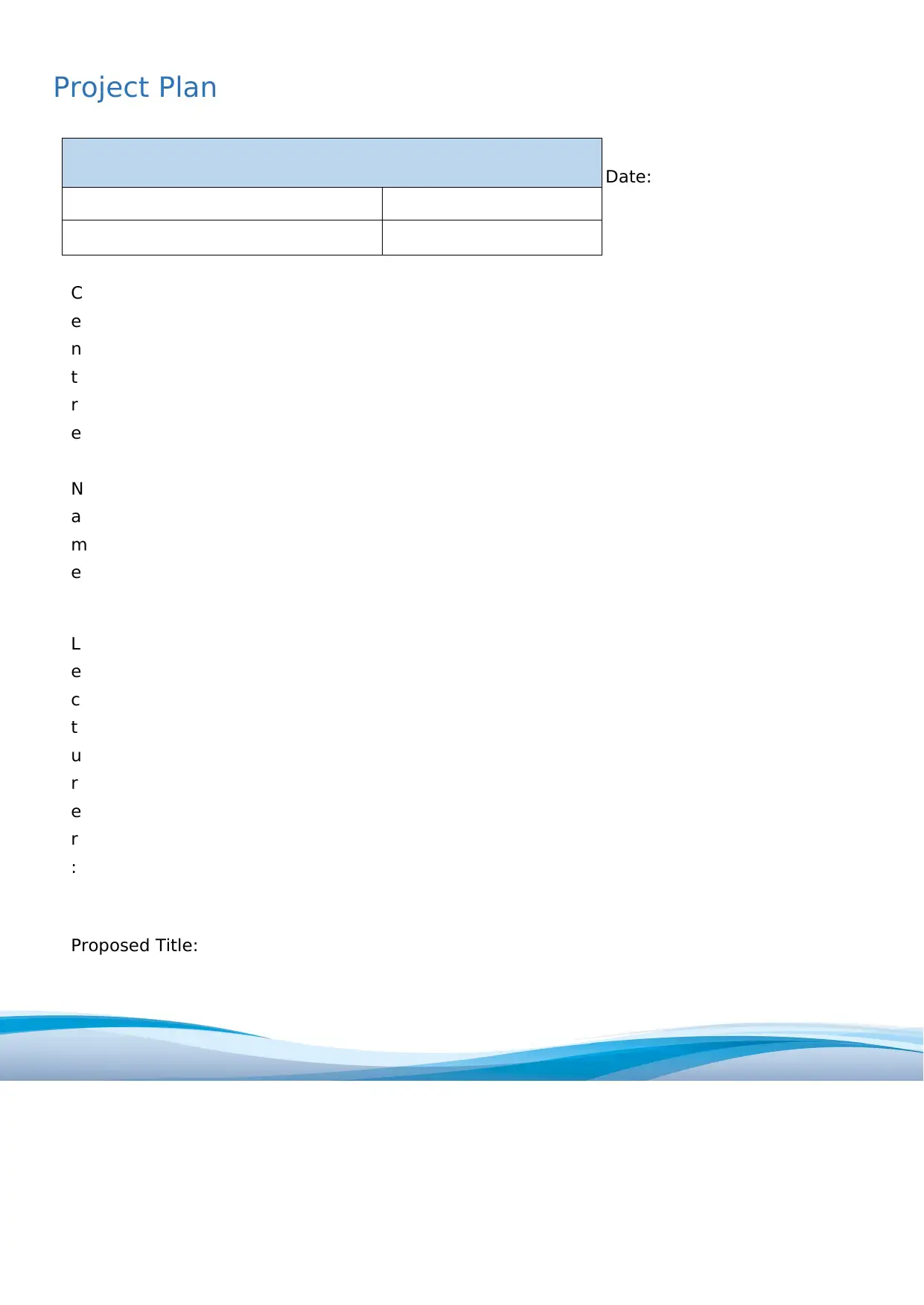
Project Plan
Date:
C
e
n
t
r
e
N
a
m
e
L
e
c
t
u
r
e
r
:
Proposed Title:
1
Date:
C
e
n
t
r
e
N
a
m
e
L
e
c
t
u
r
e
r
:
Proposed Title:
1
Paraphrase This Document
Need a fresh take? Get an instant paraphrase of this document with our AI Paraphraser
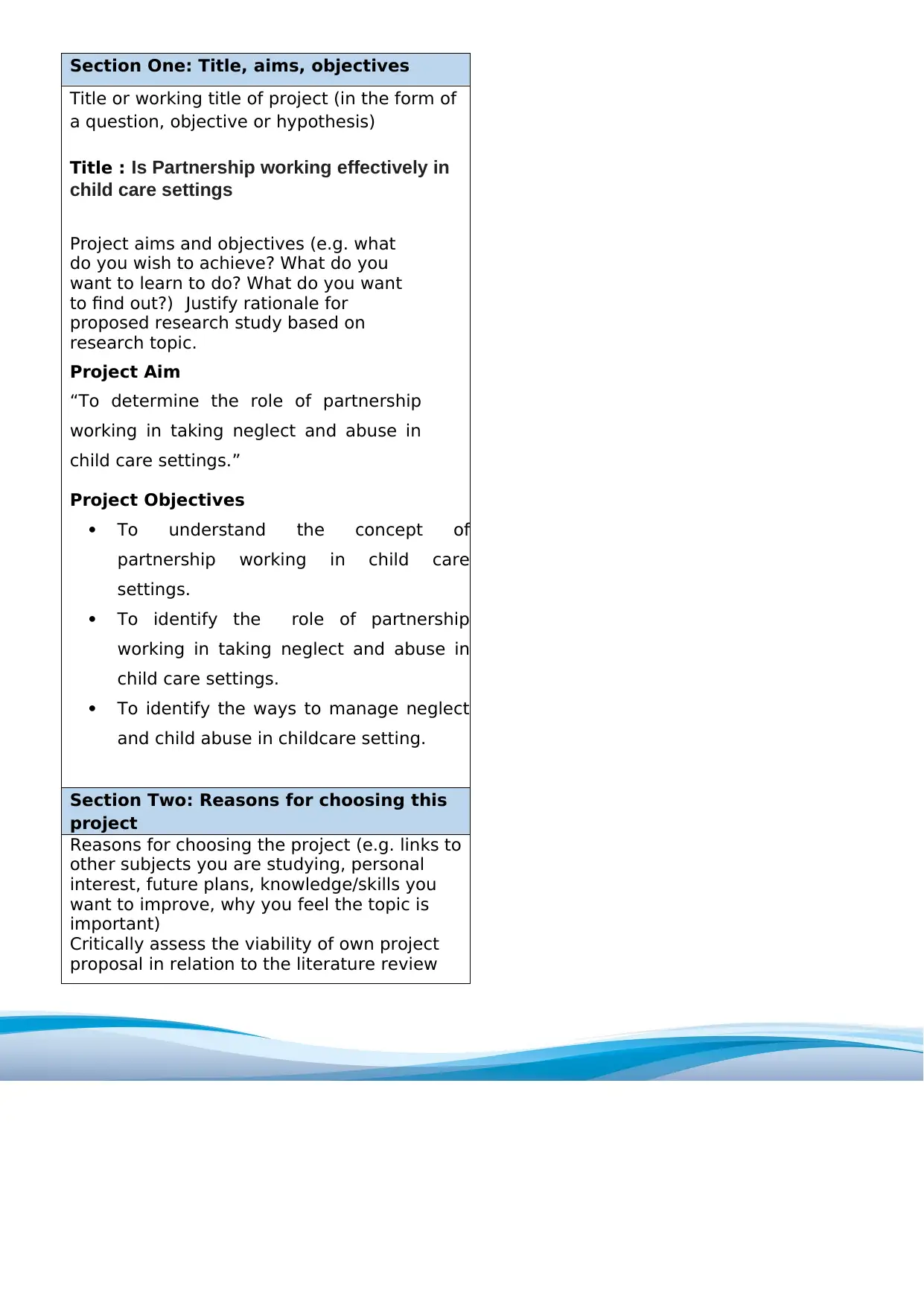
Section One: Title, aims, objectives
Title or working title of project (in the form of
a question, objective or hypothesis)
Title : Is Partnership working effectively in
child care settings
Project aims and objectives (e.g. what
do you wish to achieve? What do you
want to learn to do? What do you want
to find out?) Justify rationale for
proposed research study based on
research topic.
Project Aim
“To determine the role of partnership
working in taking neglect and abuse in
child care settings.”
Project Objectives
To understand the concept of
partnership working in child care
settings.
To identify the role of partnership
working in taking neglect and abuse in
child care settings.
To identify the ways to manage neglect
and child abuse in childcare setting.
Section Two: Reasons for choosing this
project
Reasons for choosing the project (e.g. links to
other subjects you are studying, personal
interest, future plans, knowledge/skills you
want to improve, why you feel the topic is
important)
Critically assess the viability of own project
proposal in relation to the literature review
2
Title or working title of project (in the form of
a question, objective or hypothesis)
Title : Is Partnership working effectively in
child care settings
Project aims and objectives (e.g. what
do you wish to achieve? What do you
want to learn to do? What do you want
to find out?) Justify rationale for
proposed research study based on
research topic.
Project Aim
“To determine the role of partnership
working in taking neglect and abuse in
child care settings.”
Project Objectives
To understand the concept of
partnership working in child care
settings.
To identify the role of partnership
working in taking neglect and abuse in
child care settings.
To identify the ways to manage neglect
and child abuse in childcare setting.
Section Two: Reasons for choosing this
project
Reasons for choosing the project (e.g. links to
other subjects you are studying, personal
interest, future plans, knowledge/skills you
want to improve, why you feel the topic is
important)
Critically assess the viability of own project
proposal in relation to the literature review
2

The reason behind choosing this project is to
enhance overall understanding of the concept
of partnership working in child care settings.
The topic is important and holds relevance in
the modern times. Another reason behind
choosing this project is to develop effective
written communication skills.
Section Three: Precedents and sources.
This is your literature review section.
1,500-2,000 words in length.
Use of key literature sources and precedents to
support your project objectives. Explain results
of the literature search that summarises
current knowledge about research topic.
Comment also on search string key terms used
for the lit review and comment on the
reliability of the literature review.
The concept of partnership working in
child care settings
As per the Early Years Foundations
Stages(EYFS) Framework, a partnership
includes parents, relatives, any other partner ,
and they work together for the growth of
children. Childhood setting involve the teams
from different discipline like health, education,
safety, social care and these teams are work
with the families and parents to ensure that
each child's individual need is completed.
Parents can provide the data of a child which is
confidential as it is important for the bases.
The benefit of working in the partnership in
child care setting is allowing all the families to
3
enhance overall understanding of the concept
of partnership working in child care settings.
The topic is important and holds relevance in
the modern times. Another reason behind
choosing this project is to develop effective
written communication skills.
Section Three: Precedents and sources.
This is your literature review section.
1,500-2,000 words in length.
Use of key literature sources and precedents to
support your project objectives. Explain results
of the literature search that summarises
current knowledge about research topic.
Comment also on search string key terms used
for the lit review and comment on the
reliability of the literature review.
The concept of partnership working in
child care settings
As per the Early Years Foundations
Stages(EYFS) Framework, a partnership
includes parents, relatives, any other partner ,
and they work together for the growth of
children. Childhood setting involve the teams
from different discipline like health, education,
safety, social care and these teams are work
with the families and parents to ensure that
each child's individual need is completed.
Parents can provide the data of a child which is
confidential as it is important for the bases.
The benefit of working in the partnership in
child care setting is allowing all the families to
3
⊘ This is a preview!⊘
Do you want full access?
Subscribe today to unlock all pages.

Trusted by 1+ million students worldwide
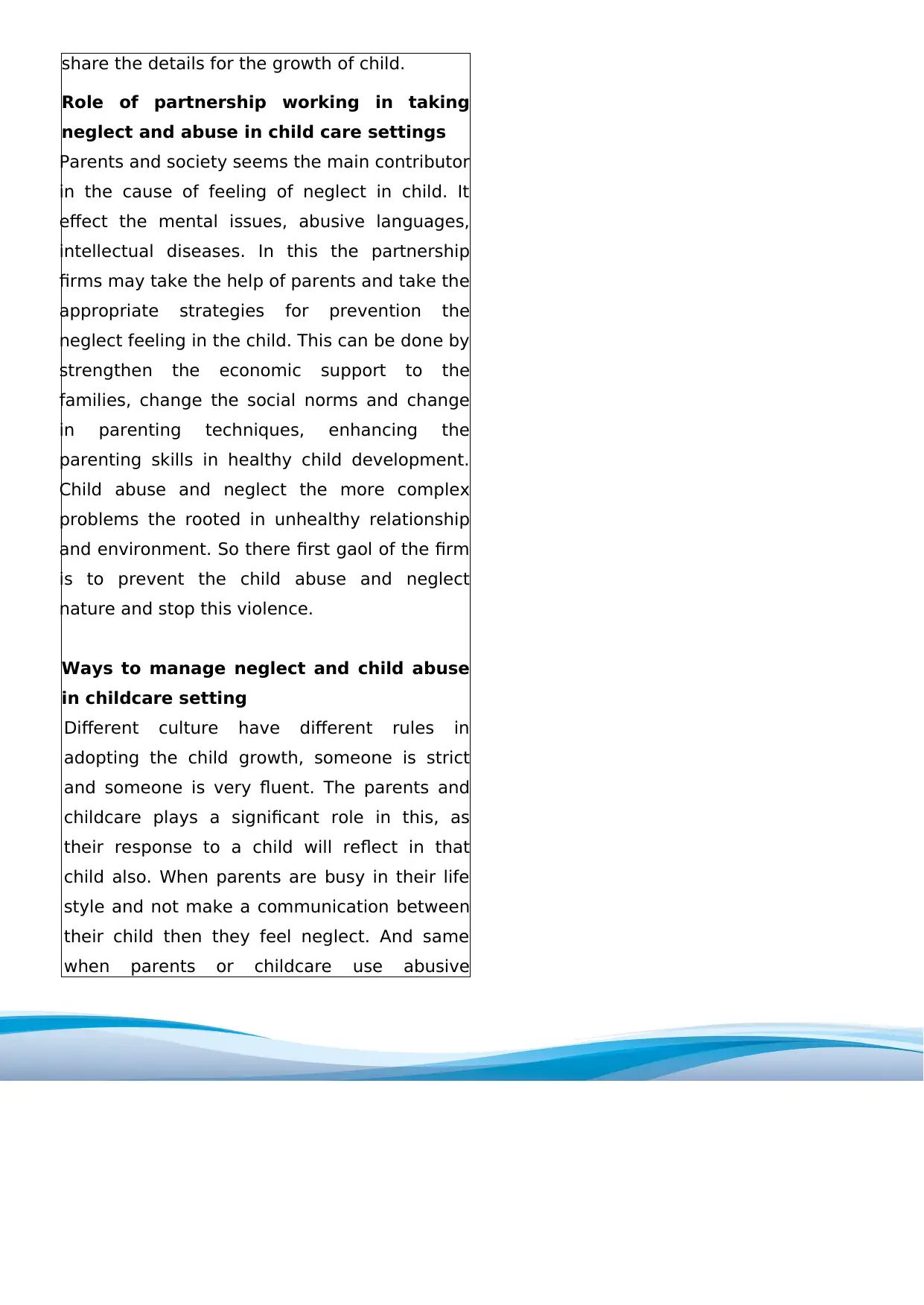
share the details for the growth of child.
Role of partnership working in taking
neglect and abuse in child care settings
Parents and society seems the main contributor
in the cause of feeling of neglect in child. It
effect the mental issues, abusive languages,
intellectual diseases. In this the partnership
firms may take the help of parents and take the
appropriate strategies for prevention the
neglect feeling in the child. This can be done by
strengthen the economic support to the
families, change the social norms and change
in parenting techniques, enhancing the
parenting skills in healthy child development.
Child abuse and neglect the more complex
problems the rooted in unhealthy relationship
and environment. So there first gaol of the firm
is to prevent the child abuse and neglect
nature and stop this violence.
Ways to manage neglect and child abuse
in childcare setting
Different culture have different rules in
adopting the child growth, someone is strict
and someone is very fluent. The parents and
childcare plays a significant role in this, as
their response to a child will reflect in that
child also. When parents are busy in their life
style and not make a communication between
their child then they feel neglect. And same
when parents or childcare use abusive
4
Role of partnership working in taking
neglect and abuse in child care settings
Parents and society seems the main contributor
in the cause of feeling of neglect in child. It
effect the mental issues, abusive languages,
intellectual diseases. In this the partnership
firms may take the help of parents and take the
appropriate strategies for prevention the
neglect feeling in the child. This can be done by
strengthen the economic support to the
families, change the social norms and change
in parenting techniques, enhancing the
parenting skills in healthy child development.
Child abuse and neglect the more complex
problems the rooted in unhealthy relationship
and environment. So there first gaol of the firm
is to prevent the child abuse and neglect
nature and stop this violence.
Ways to manage neglect and child abuse
in childcare setting
Different culture have different rules in
adopting the child growth, someone is strict
and someone is very fluent. The parents and
childcare plays a significant role in this, as
their response to a child will reflect in that
child also. When parents are busy in their life
style and not make a communication between
their child then they feel neglect. And same
when parents or childcare use abusive
4
Paraphrase This Document
Need a fresh take? Get an instant paraphrase of this document with our AI Paraphraser
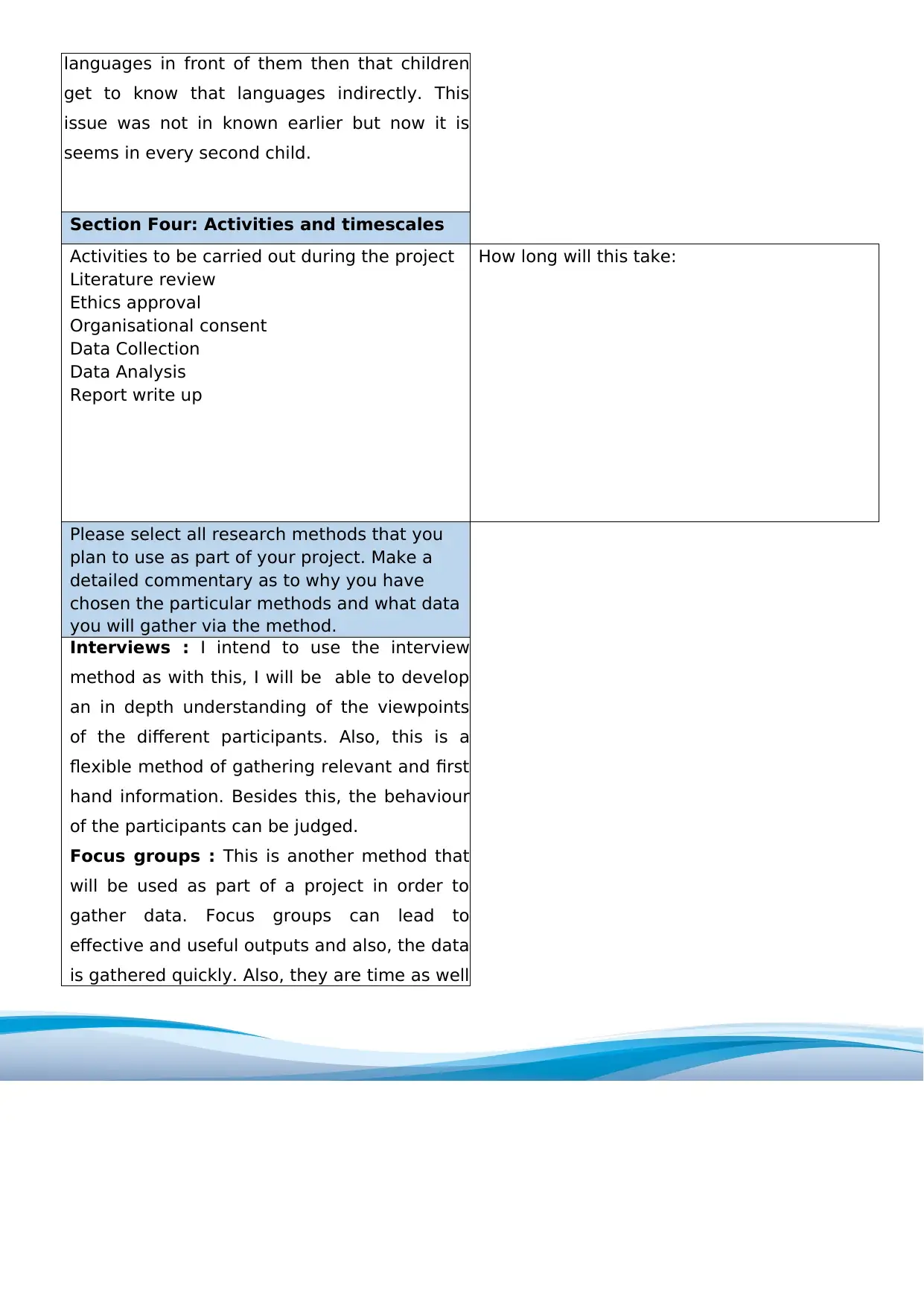
languages in front of them then that children
get to know that languages indirectly. This
issue was not in known earlier but now it is
seems in every second child.
Section Four: Activities and timescales
Activities to be carried out during the project
Literature review
Ethics approval
Organisational consent
Data Collection
Data Analysis
Report write up
How long will this take:
Please select all research methods that you
plan to use as part of your project. Make a
detailed commentary as to why you have
chosen the particular methods and what data
you will gather via the method.
Interviews : I intend to use the interview
method as with this, I will be able to develop
an in depth understanding of the viewpoints
of the different participants. Also, this is a
flexible method of gathering relevant and first
hand information. Besides this, the behaviour
of the participants can be judged.
Focus groups : This is another method that
will be used as part of a project in order to
gather data. Focus groups can lead to
effective and useful outputs and also, the data
is gathered quickly. Also, they are time as well
5
get to know that languages indirectly. This
issue was not in known earlier but now it is
seems in every second child.
Section Four: Activities and timescales
Activities to be carried out during the project
Literature review
Ethics approval
Organisational consent
Data Collection
Data Analysis
Report write up
How long will this take:
Please select all research methods that you
plan to use as part of your project. Make a
detailed commentary as to why you have
chosen the particular methods and what data
you will gather via the method.
Interviews : I intend to use the interview
method as with this, I will be able to develop
an in depth understanding of the viewpoints
of the different participants. Also, this is a
flexible method of gathering relevant and first
hand information. Besides this, the behaviour
of the participants can be judged.
Focus groups : This is another method that
will be used as part of a project in order to
gather data. Focus groups can lead to
effective and useful outputs and also, the data
is gathered quickly. Also, they are time as well
5
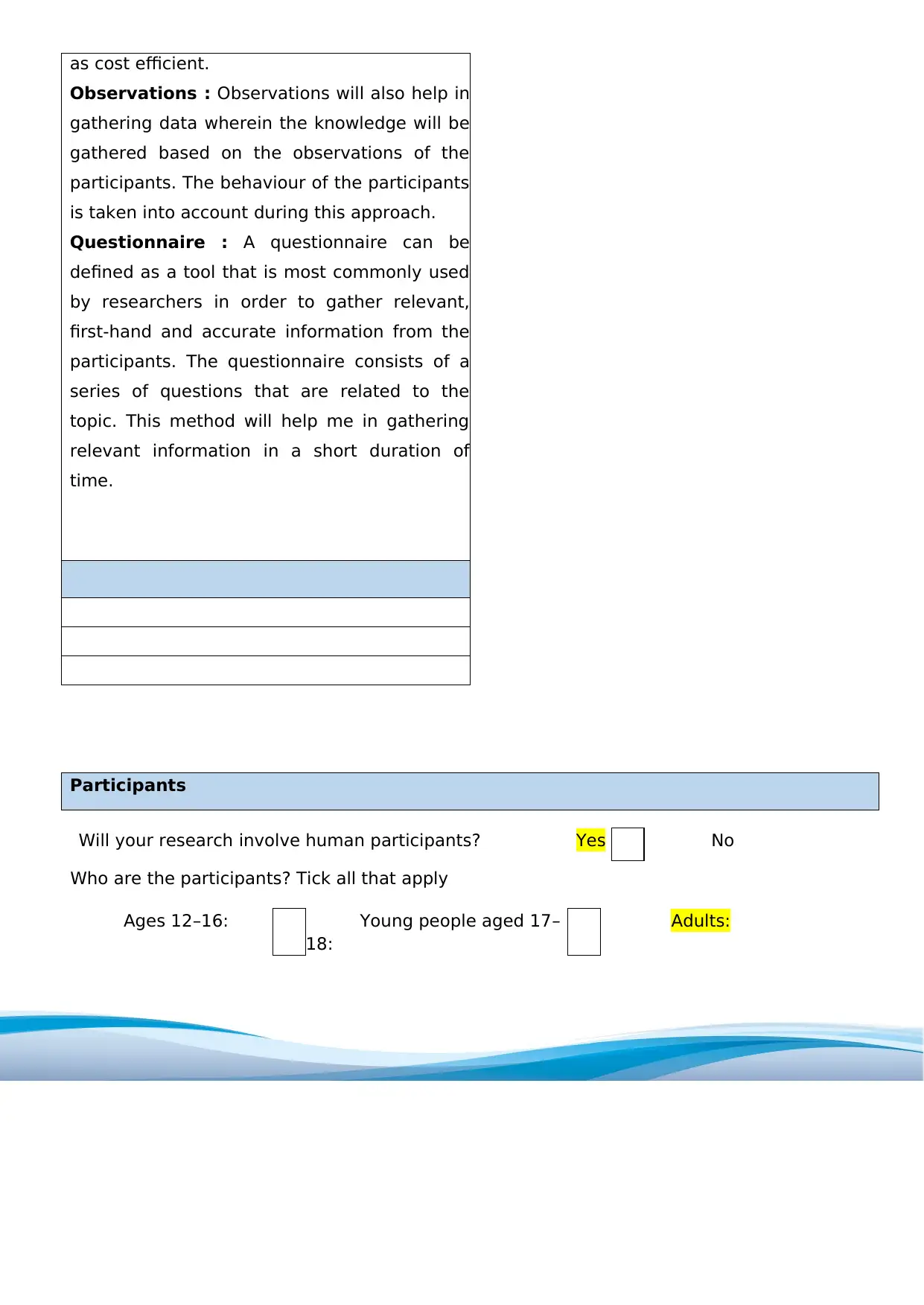
as cost efficient.
Observations : Observations will also help in
gathering data wherein the knowledge will be
gathered based on the observations of the
participants. The behaviour of the participants
is taken into account during this approach.
Questionnaire : A questionnaire can be
defined as a tool that is most commonly used
by researchers in order to gather relevant,
first-hand and accurate information from the
participants. The questionnaire consists of a
series of questions that are related to the
topic. This method will help me in gathering
relevant information in a short duration of
time.
Participants
Will your research involve human participants? Yes No
Who are the participants? Tick all that apply
Ages 12–16: Young people aged 17–
18:
Adults:
6
Observations : Observations will also help in
gathering data wherein the knowledge will be
gathered based on the observations of the
participants. The behaviour of the participants
is taken into account during this approach.
Questionnaire : A questionnaire can be
defined as a tool that is most commonly used
by researchers in order to gather relevant,
first-hand and accurate information from the
participants. The questionnaire consists of a
series of questions that are related to the
topic. This method will help me in gathering
relevant information in a short duration of
time.
Participants
Will your research involve human participants? Yes No
Who are the participants? Tick all that apply
Ages 12–16: Young people aged 17–
18:
Adults:
6
⊘ This is a preview!⊘
Do you want full access?
Subscribe today to unlock all pages.

Trusted by 1+ million students worldwide
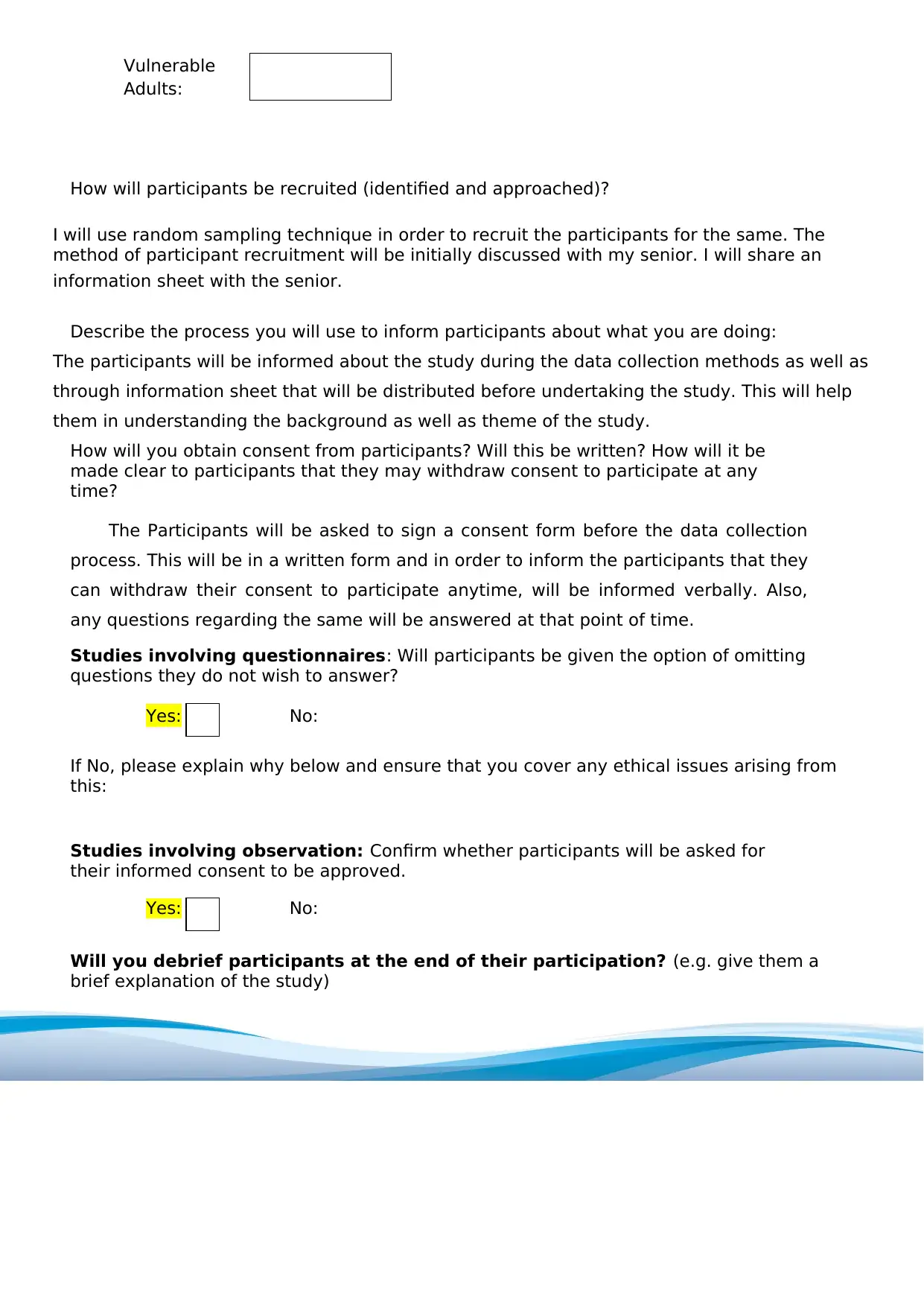
Vulnerable
Adults:
How will participants be recruited (identified and approached)?
I will use random sampling technique in order to recruit the participants for the same. The
method of participant recruitment will be initially discussed with my senior. I will share an
information sheet with the senior.
Describe the process you will use to inform participants about what you are doing:
The participants will be informed about the study during the data collection methods as well as
through information sheet that will be distributed before undertaking the study. This will help
them in understanding the background as well as theme of the study.
How will you obtain consent from participants? Will this be written? How will it be
made clear to participants that they may withdraw consent to participate at any
time?
The Participants will be asked to sign a consent form before the data collection
process. This will be in a written form and in order to inform the participants that they
can withdraw their consent to participate anytime, will be informed verbally. Also,
any questions regarding the same will be answered at that point of time.
Studies involving questionnaires: Will participants be given the option of omitting
questions they do not wish to answer?
Yes: No:
If No, please explain why below and ensure that you cover any ethical issues arising from
this:
Studies involving observation: Confirm whether participants will be asked for
their informed consent to be approved.
Yes: No:
Will you debrief participants at the end of their participation? (e.g. give them a
brief explanation of the study)
7
Adults:
How will participants be recruited (identified and approached)?
I will use random sampling technique in order to recruit the participants for the same. The
method of participant recruitment will be initially discussed with my senior. I will share an
information sheet with the senior.
Describe the process you will use to inform participants about what you are doing:
The participants will be informed about the study during the data collection methods as well as
through information sheet that will be distributed before undertaking the study. This will help
them in understanding the background as well as theme of the study.
How will you obtain consent from participants? Will this be written? How will it be
made clear to participants that they may withdraw consent to participate at any
time?
The Participants will be asked to sign a consent form before the data collection
process. This will be in a written form and in order to inform the participants that they
can withdraw their consent to participate anytime, will be informed verbally. Also,
any questions regarding the same will be answered at that point of time.
Studies involving questionnaires: Will participants be given the option of omitting
questions they do not wish to answer?
Yes: No:
If No, please explain why below and ensure that you cover any ethical issues arising from
this:
Studies involving observation: Confirm whether participants will be asked for
their informed consent to be approved.
Yes: No:
Will you debrief participants at the end of their participation? (e.g. give them a
brief explanation of the study)
7
Paraphrase This Document
Need a fresh take? Get an instant paraphrase of this document with our AI Paraphraser
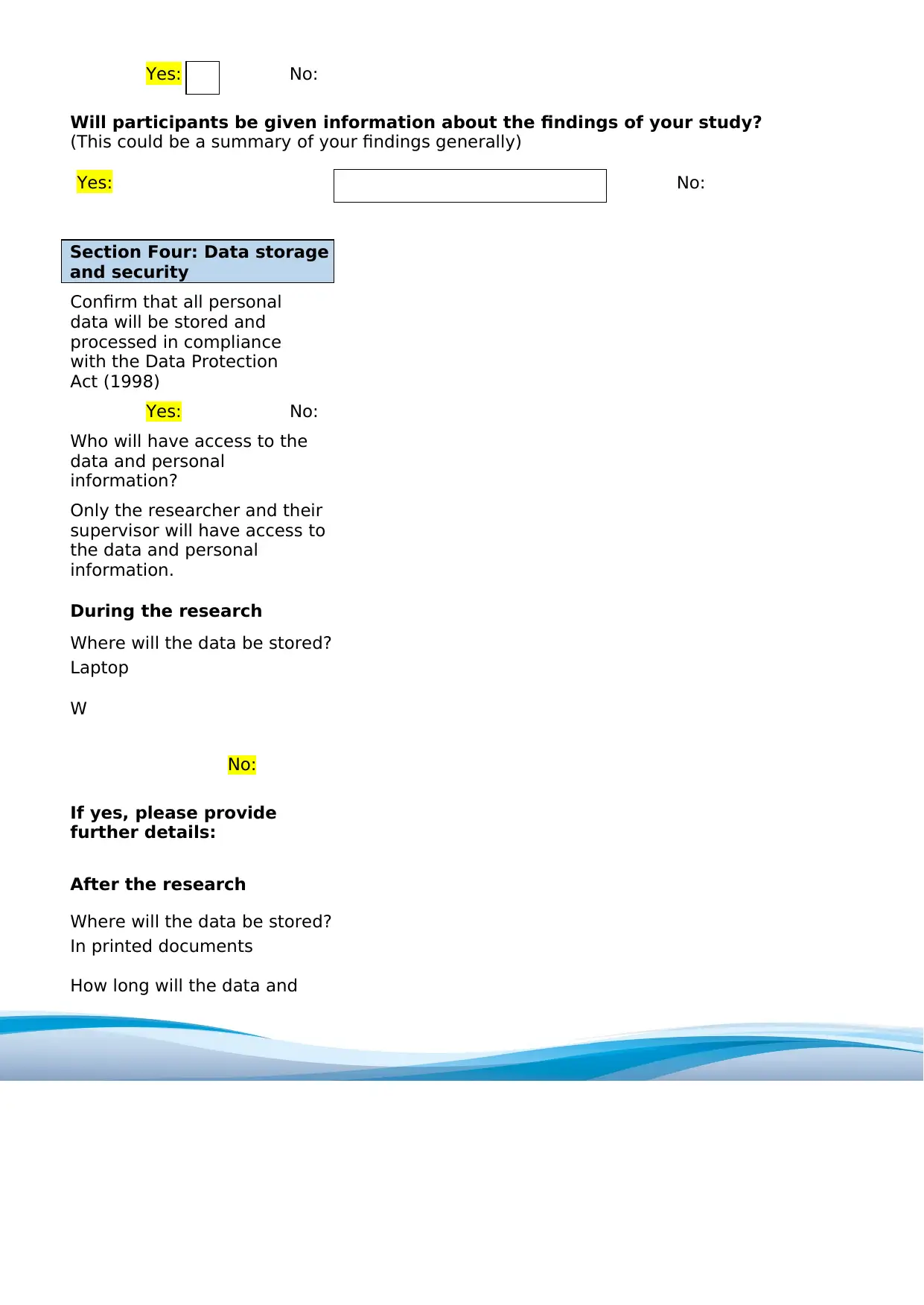
Yes: No:
Will participants be given information about the findings of your study?
(This could be a summary of your findings generally)
Yes: No:
Section Four: Data storage
and security
Confirm that all personal
data will be stored and
processed in compliance
with the Data Protection
Act (1998)
Yes: No:
Who will have access to the
data and personal
information?
Only the researcher and their
supervisor will have access to
the data and personal
information.
During the research
Where will the data be stored?
Laptop
W
No:
If yes, please provide
further details:
After the research
Where will the data be stored?
In printed documents
How long will the data and
8
Will participants be given information about the findings of your study?
(This could be a summary of your findings generally)
Yes: No:
Section Four: Data storage
and security
Confirm that all personal
data will be stored and
processed in compliance
with the Data Protection
Act (1998)
Yes: No:
Who will have access to the
data and personal
information?
Only the researcher and their
supervisor will have access to
the data and personal
information.
During the research
Where will the data be stored?
Laptop
W
No:
If yes, please provide
further details:
After the research
Where will the data be stored?
In printed documents
How long will the data and
8

records be kept, and in what
format?
The data will not be stored for
a long period of time.
W
No:
If yes, please provide
further details:
9
format?
The data will not be stored for
a long period of time.
W
No:
If yes, please provide
further details:
9
⊘ This is a preview!⊘
Do you want full access?
Subscribe today to unlock all pages.

Trusted by 1+ million students worldwide
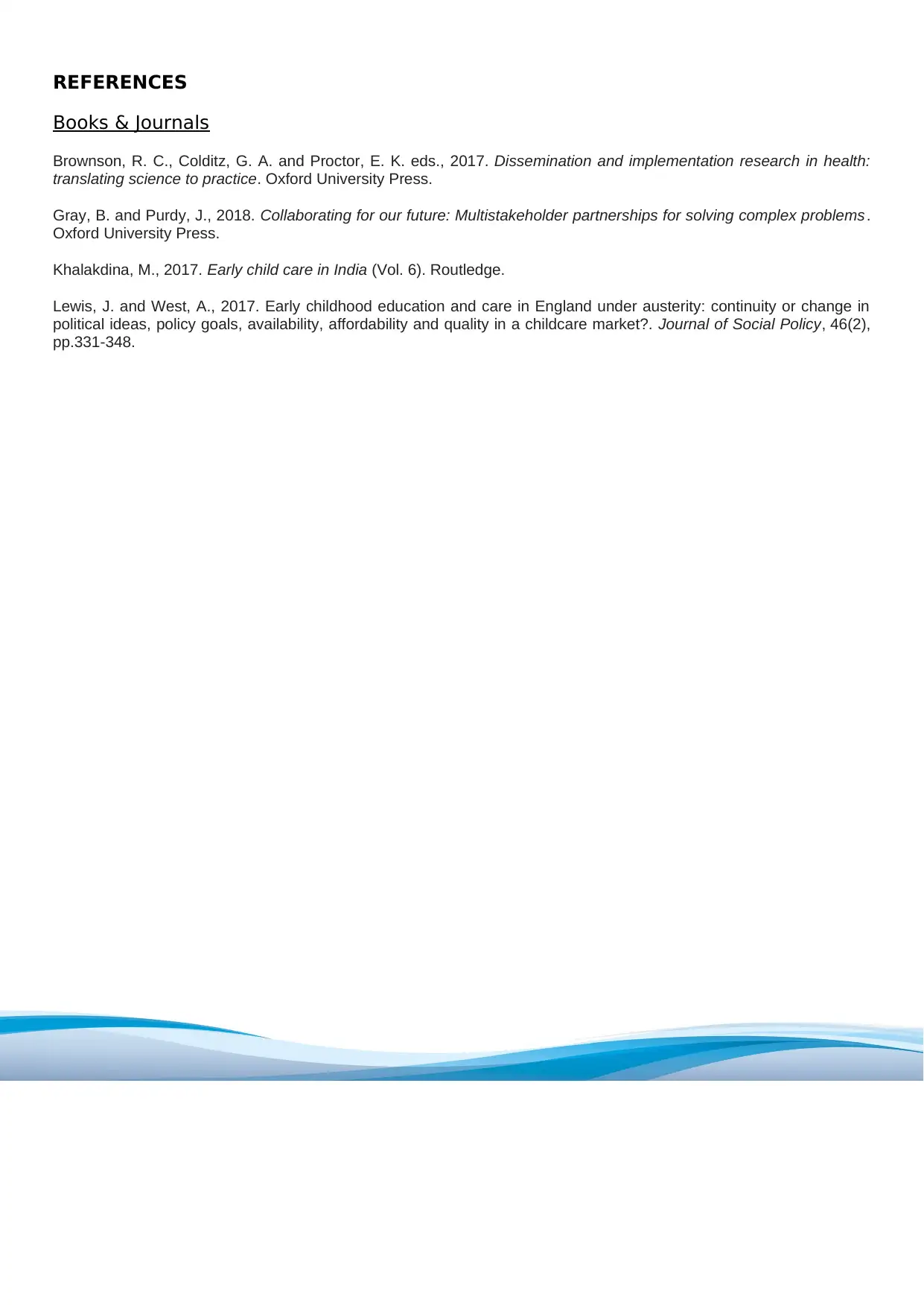
REFERENCES
Books & Journals
Brownson, R. C., Colditz, G. A. and Proctor, E. K. eds., 2017. Dissemination and implementation research in health:
translating science to practice. Oxford University Press.
Gray, B. and Purdy, J., 2018. Collaborating for our future: Multistakeholder partnerships for solving complex problems.
Oxford University Press.
Khalakdina, M., 2017. Early child care in India (Vol. 6). Routledge.
Lewis, J. and West, A., 2017. Early childhood education and care in England under austerity: continuity or change in
political ideas, policy goals, availability, affordability and quality in a childcare market?. Journal of Social Policy, 46(2),
pp.331-348.
1
Books & Journals
Brownson, R. C., Colditz, G. A. and Proctor, E. K. eds., 2017. Dissemination and implementation research in health:
translating science to practice. Oxford University Press.
Gray, B. and Purdy, J., 2018. Collaborating for our future: Multistakeholder partnerships for solving complex problems.
Oxford University Press.
Khalakdina, M., 2017. Early child care in India (Vol. 6). Routledge.
Lewis, J. and West, A., 2017. Early childhood education and care in England under austerity: continuity or change in
political ideas, policy goals, availability, affordability and quality in a childcare market?. Journal of Social Policy, 46(2),
pp.331-348.
1
1 out of 10
Related Documents
Your All-in-One AI-Powered Toolkit for Academic Success.
+13062052269
info@desklib.com
Available 24*7 on WhatsApp / Email
![[object Object]](/_next/static/media/star-bottom.7253800d.svg)
Unlock your academic potential
Copyright © 2020–2025 A2Z Services. All Rights Reserved. Developed and managed by ZUCOL.





